Don't forget to feed the birds
Inviting birds into a garden is just one of the joys of having a garden. Not only are they beautiful to look at, birds are invaluable for keeping pests under control.
Winter feels like it’s here and the first heavy rains and cold chills have forced us all indoors. Not so for the birds! They are on a last ditch attempt to fatten up before the winter and can be seen looking for food. In the past, most of our indigenous birds survived well during our winters and found enough food. However, their available habitats are now being more and more encroached upon by new houses and developments. With their food sources dwindling, it is nice to give them a helping hand at this time of the year. Their primary diet of seeding grasses and weeds, flowering and fruiting trees and insects only provides flushes of food during the year, and there are inevitably lean times when handouts, from those wanting to attract them to their garden, are welcome.
For Nectar drinkers
Common nectar drinkers in the garden are the cute white-eyes, and the beautiful sunbirds. You can easily make a DIY nectar feeder from an old cool drink bottle or from a modified drip-water-bottle usually used for caged hamsters and rodents. Most nurseries also stock ‘hummingbird’ feeders.
To help nectar drinkers recognize their new food source, the spout should be painted bright red (and the solution dyed red) and hung in an open spot near red flowered bush or tree that is already being used as a food station. Fill the feeder with a sugary solution (white sugar only), about 20% sugar with water.
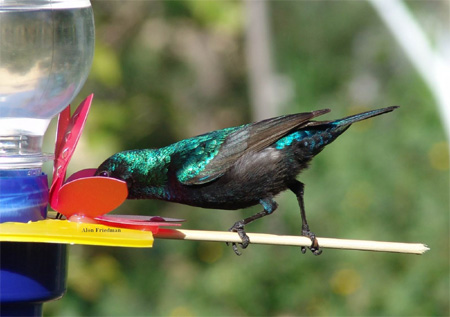
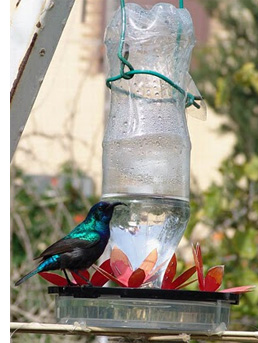 Recycle a plastic bottle, an old coathanger and a CD case to make a nectar feeder for your garden.
Recycle a plastic bottle, an old coathanger and a CD case to make a nectar feeder for your garden.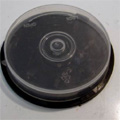
Make a hole in the bottom of the CD case to accept the top of the bottle and secure this in place with silicone sealant.
When dry, bend the coathanger to fit around the bottle and to hang on a high branch in the garden. Unscrew the top of the CD case and fill the bottle with nectar and hang. Decorate with plastic flowers cut from coloured plastic bottles and use a glue gun to attach.
Grain feeders
Seeds of grasses and other cereals are easiest to provide and literally any type will do. Generally the smaller the grain, the more popular it will be with a variety of birds. Lawn seed is often very popular! Millet, often sold in a mixture with other grains called ‘wild bird seed’ is also an easily available source. Feeding on the ground won’t necessarily bring the best results as the doves and pigeons will move in quickly denying the smaller birds a chance. Elevate the food table or use a swinging tray from a tree branch (better as the doves can’t land on it), the higher the better, so the birds can keep a good lookout for cats and other predators.
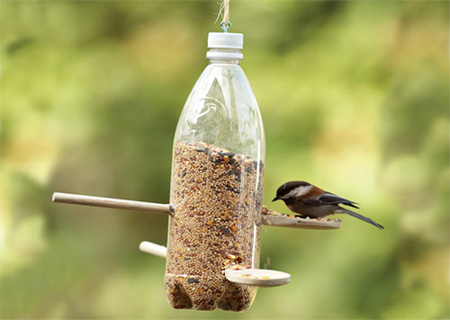
Recycle a plastic bottle and a couple of old wooden spoons into a winter feeder for seed-eating birds. Use a sharp knife or drill to cut holes into the bottles sides for the spoons, push in and then fill up with seeds to hang high on a branch.
Fruit feeders
Fruit offerings shouldn’t be left on the ground, as generally the birds familiar with fruit are used to it being up in the trees. While some species are used to eating ripe fruit off the ground, generally it is better to put whole fruits (not cut up pieces as they dry out) onto a nail, spike or thorny branch to prevent the fruits being knocked off onto the ground. Apple and pears are good, but don’t forget the soft fruits as well such as avo, pawaw, orange and banana which the white-eyes love. Apples are particularly loved by black collared and crested barbets.
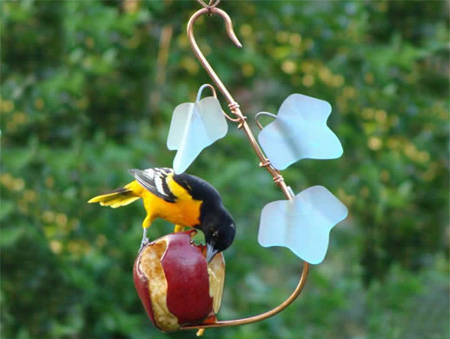
Fruit-loving birds require nothing more than a hook, suspended from a high branch, with fresh fruit on a regular basis.
Meat-eaters
The meat-eaters would be happy for an offering of suet or bonemeal. Common shrikes, fiscals, bokmakierie and tits as well as white-eyes will be attracted. The suet and bonemeal can be hung in separate bags from tree branches in netting bags. A small branch next to it will help other species of birds who can’t hang from the bag itself . A suet cake can easily be made, using broken peanuts, raisins, honey, bran or pronutro and dried powdered peas, beans or lentils and melted suet. Mix this all up together after the suet has melted and while cooling. Allow the mixture to set in chunks or press into the spaces on a pinecone for convenient bird take-aways!
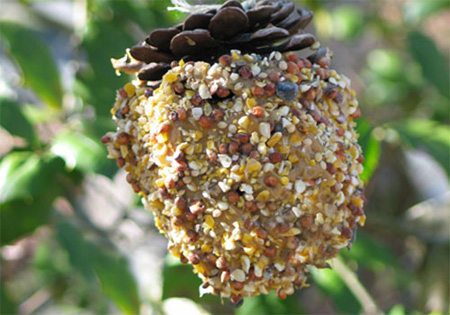
Pine cones comes in useful for making bird feeders. Mix up lard with pronutro and pack into the openings in the cone and then cover with assorted seeds.






0 comments:
Post a Comment